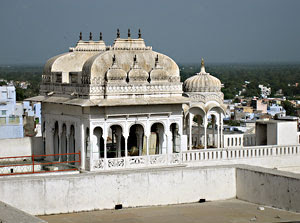Location: On Trikoot Parvat (Hill), in Katra of Udhampur district at Jammu
Dedicated to: Goddess Vaishnavi
Attraction: Major pilgrimage of the Hindus
Vaishno Devi Temple is the most-sought after pilgrimage of the Hindus. Located at Trikoot Parvat, Mata Vaishno Mandir is the holiest shrine of India and it is famous all over the World. The temple is accessible by a journey of 13 kms from Katra. Katra is a small town that falls in Udhampur district of Jammu. From Jammu, Katra lies at a distance of 50 kms. In the northern part of India, many rail-services are available to reach Jammu.
Vaishno Devi Shrine is placed at an altitude of 5200 feet above sea level. Vaishno Devi is the second most-visited shrines of India, first being the Balaji Temple at Tirupati. The temple is managed and maintained by Shri Mata Vaishno Devi Shrine Board. Vaishno Devi is regarded as the incarnation of Durga (Shakti). Every year, millions of pilgrims visit the holy shrine of Vaishno Devi. There is a legend behind the establishment of this temple.
Legend of Vaishno Devi
According to the legends, Vaishno Devi took birth around 700 years ago. The girl was a true devotee of Lord Rama (an incarnation of Lord Vishnu) and swore to remain celibate throughout her life. In those times, Bhairon Nath learned about the powers of the Goddess. Being a tantrik, he tried to capture the girl with powers. With his tantric (black-magic) powers, he saw the girl going towards Trikoot Mountain.
Unaware about the Goddess, Bhairon Nath started to chase the girl. The Goddess ran to save herself, when she felt thirsty, she shot an arrow in the ground and the water gushed out. Ever since, the gush is flowing ceaselessly and is known as Ban Ganga. Till date, the imprints of her feet are marked on the banks of Ban Ganga and known as 'Charan Paduka'. After this incident, the Goddess went into a cave at Ardhkuari for meditation.
Bhairon Nath took around nine months to find this cave. The meditation was disturbed when Bhairon came at the cave and the Goddess made on opening at the other end of the cave with her trident. From that time, this cave came to be known as 'Garbha Joon'. The Goddess ran further on the hill and when Bhairon tried to kill Vaishno Devi, she emerged in the form of Maha Kali. She cut off Bhairon Nath's head, which flung up the mountain by the force of the blow.
Today, Bhairon Temple is standing on the place where once his head was knocked down. The area is known as Bhairon Ghati and it is at a distance of 2.5 kms from the holy cave. In the last moments, Bhairav Nath beseeched the Goddess for forgiveness. Vaishno Devi knew that the objective behind the attack was to attain salvation. The Goddess liberated Bhairon from the cycle of life and death.
In addition to it, Mata acclaimed that whosoever, come to her cave also has to visit Bhairon Temple in order to complete their pilgrimage. Soon after this, Vaishno assumed the image of a rock in the form of three 'Pindis' and absorbed herself into meditation forever. As per the sayings, the rock at the entrance of the holy cave is the horrified torso of Bhairon Nath, who was forgiven by Vaishno Devi in his last moments.
The Holy Cave
In the cave, one can see the blissful 'pindis' of Maha Kali, Maha Lakshmi and Maha Saraswati. Mata Vaishno Devi is regarded as the granter of boons. She fulfills the wishes of her devotes and no one goes empty handed from her shrine. With faith in mind, people come to the temple of Vaishno Devi to seek the blessings of the Supreme power.
In the earlier days, the journey of Vaishno Devi used to be difficult with steep roads, but in the present day, the way has been made much easier than before. For the convenience of pilgrims, Horses are available that take you up to the Hill. However, people prefer to trek the way from Katra to the Bhawan (Cave). According to pilgrims, all the weariness gets off at the single glimpse of Maa Vaishno.
The pilgrims walk the whole way by chanting 'Jai Mata Di' in groups. At Katra, various shops sell flowers, coconuts, dry-fruits and other things that people buy to make an offering to the Goddess. The entire way to the shrine is well-lighted and adequate arrangements of water and public-convenience have been made to facilitate the pilgrims. The divine grace of the Goddess brings her devotees to this pilgrimage of religious importance.




















